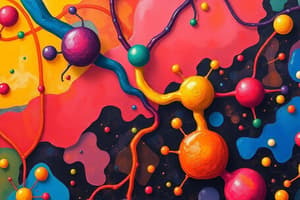Podcast
Questions and Answers
What is the primary function of catabolic pathways?
What is the primary function of catabolic pathways?
- To synthesize larger molecules using energy.
- To convert inorganic carbon dioxide into organic carbon compounds.
- To generate energy by breaking down larger molecules. (correct)
- To break down small molecules into larger ones.
What is the term for organisms that convert inorganic carbon dioxide into organic carbon compounds?
What is the term for organisms that convert inorganic carbon dioxide into organic carbon compounds?
- Phototrophs
- Heterotrophs
- Chemotrophs
- Autotrophs (correct)
What is the energy source used by organisms that get their energy for electron transfer from light?
What is the energy source used by organisms that get their energy for electron transfer from light?
- Light energy (correct)
- Chemical energy
- Mechanical energy
- Thermal energy
What is the term for the process of assembling smaller molecules into larger ones using energy?
What is the term for the process of assembling smaller molecules into larger ones using energy?
What is the primary function of anabolic pathways?
What is the primary function of anabolic pathways?
Which type of organisms relies on more complex organic carbon compounds as nutrients?
Which type of organisms relies on more complex organic carbon compounds as nutrients?
What is the term for the process of breaking down larger molecules into smaller ones releasing energy?
What is the term for the process of breaking down larger molecules into smaller ones releasing energy?
What is the energy source used by organisms that get their energy for electron transfer from chemicals?
What is the energy source used by organisms that get their energy for electron transfer from chemicals?
What is the term used to describe the chemical reactions that occur within a cell?
What is the term used to describe the chemical reactions that occur within a cell?
Which type of metabolic pathway involves the breakdown of complex molecules into simpler ones?
Which type of metabolic pathway involves the breakdown of complex molecules into simpler ones?
What is the primary function of anabolic metabolic pathways?
What is the primary function of anabolic metabolic pathways?
Which of the following reactions require energy to proceed?
Which of the following reactions require energy to proceed?
What is the term used to describe metabolic pathways that are spontaneous and release energy?
What is the term used to describe metabolic pathways that are spontaneous and release energy?
What is likely causing Hannah's symptoms in the Clinical Focus?
What is likely causing Hannah's symptoms in the Clinical Focus?
What is the term used to describe the series of stepwise, interconnected chemical reactions in a cell?
What is the term used to describe the series of stepwise, interconnected chemical reactions in a cell?
What is the primary difference between anabolic and catabolic metabolic pathways?
What is the primary difference between anabolic and catabolic metabolic pathways?
Flashcards are hidden until you start studying
Study Notes
Metabolism
- Metabolism is the term used to describe all the chemical reactions that occur inside a cell.
- It involves a series of stepwise, interconnected chemical reactions called metabolic pathways.
- Metabolic pathways can be either anabolic (energy-requiring) or catabolic (energy-releasing).
Anabolism and Catabolism
- Anabolism refers to endergonic metabolic pathways involved in biosynthesis, converting simple molecules into complex ones.
- Anabolic pathways require energy to synthesize larger molecules.
- Catabolism refers to exergonic pathways that break down complex molecules into simpler ones.
- Catabolic pathways generate energy by breaking down larger molecules.
- Both anabolic and catabolic pathways are required for maintaining the cell's energy balance.
Classification by Carbon and Energy Source
- Organisms can be classified according to the source of carbon they use for metabolism.
- Autotrophs convert inorganic carbon dioxide (CO2) into organic carbon compounds.
- Examples of autotrophs include plants and cyanobacteria.
- Heterotrophs rely on complex organic carbon compounds as nutrients, initially provided by autotrophs.
- Examples of heterotrophs include humans and many prokaryotes, such as Escherichia coli.
- Organisms can also be classified according to their energy source.
- Phototrophs obtain energy for electron transfer from light.
- Chemotrophs obtain energy for electron transfer from chemicals.
Energy and Molecules
- Molecular energy is stored in the bonds of complex molecules and released in catabolic pathways.
- This energy is harvested and used to produce high-energy molecules, which drive anabolic pathways.
- Cells continually balance catabolism with anabolism in terms of energy and molecules.
Studying That Suits You
Use AI to generate personalized quizzes and flashcards to suit your learning preferences.



